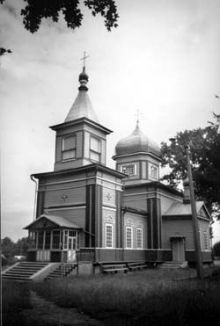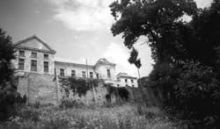This is a small town with an ordinary name that is understandable to Ukrainians. However, for those with at least a passing knowledge of Ukrainian history this name immediately conjures up associations, for this town is the ancestral home of the Princes Vyshnevetsky (Wisniowiecki), who made a significant impact not only on Ukrainian history but also on the histories of Poland, Moldova, and Russia. At least two representatives of this clan are well known: Dmytro Vyshnevetsky and his grandson Yarema (Jeremi).
Vyshnivets is an ancient town that was much favored by settlers. Settlements of the Trypillia and Cherniahiv cultures were unearthed nearby. Entering Vyshnivets, you can sense a certain mystical grace of this land, with its rich chornozem topsoil, picture-perfect, tree-clad hills, and the River Horyn, which has its start in the vicinity.
Although a walled city stood here in the times of Kyivan Rus’, the first written mention of Vyshnivets appeared much later — in 1395. Since then this settlement was home to the ancestral estate of the Vyshnevetsky clan. It is the probable birth place of Dmytro Vyshnevetsky, who is often identified with the protagonist of the Ukrainian folk song about Baida. In the popular imagination he is considered primarily as the founder of the Cossack state, the Zaporozhian Sich. His fascinating and energetic personality would probably eclipse Alexandre Dumas’ most colorful characters.
Mykhailo Vyshnevetsky and his wife Rayina Mohylianka, sister of the famous religious scholar St. Petro Mohyla, lived in Vyshnivets, where they died and were buried. They were entombed in the Church of the Ascension, which is still standing. They were Orthodox zealots, unlike their son Yarema, who is portrayed in an extremely negative fashion in Ukrainian literature as a perceived enemy of the Ukrainian nation and Orthodoxy, and a sworn adversary of Bohdan Khmelnytsky and the Cossack rebels. The evenhandedness of this portrayal is questionable, however. Let us not forget Yarema Vyshnevetsky’s generous contribution to the development of Left-Bank Ukraine, where he proved an able organizer and administrator. Under his patronage villages and towns flourished in the Lubny area, where he also helped establish several Orthodox monasteries. Somehow this has been forgotten, much like the fact that during the Khmelnytsky insurrection of 1651 he defended the rights of the Pochayiv Monastery, which was devastated three years earlier by rebellious villagers.
During Yarema’s lifetime a stone castle was built in Vyshnivets. In the 1720s the last of the Vyshnevetsky clan, Mykhailo Servatiy, rebuilt the castle into a palace that housed an extensive library and art gallery. A magnificent park was laid out on the site of the old garden. The new owners, the Counts Mniszek, to whom Vyshnivets passed after 1744, were committed to developing the palace and furnishing it with expensive furniture and sculptures. The banquet room was sumptuously decorated with handmade Dutch tiles, and the walls were adorned with numerous paintings, including canvases by famous Western European artists. The palace also had its own theater with a performance hall.
In the 18th century Vyshnivets was a major cultural center in Volhynia and all of Ukraine. In 1742 a chemist’s shop opened here, becoming one of the first pharmacies on Ukrainian soil. Aside from the palace, the town was home to interesting monuments of architecture, such as the Roman Catholic Carmelite monastery complex and St. Michael’s Roman Catholic Church adjoining the palace. The Church of the Ascension housed various ancient icons, and the Nativity of the Virgin Mary Church dominated the old part of Vyshnivets.
Not surprisingly, the town was a magnet for influential and prominent people. The successor to the Russian throne, Grand Prince Pavel Petrovich, visited the town in 1781. The Ukrainian historian and writer Mykola Kostomarov paid a special visit to Vyshnivets, describing it in great detail in his Autobiography.
It may have been on Kostomarov’s recommendation that Taras Shevchenko supposedly visited Vyshnivets during his 1846 tour of Volhynia. The town’s residents staunchly believe that the Great Bard graced their town with his presence, and they like to point out a bench in the park near the palace, where Shevchenko did his drawings or composed poetry. The monument to Shevchenko towers in the very heart of Vyshnivets.
However, there is no documented evidence that Shevchenko ever stayed in Vyshnivets, and he never refers to this town in his works. The only proof of his presence here are the reminiscences of Fedir Kruzhylka, the former stableman of the Counts Mniszek, which were recorded by Vasyl Shchurat in 1905. Kruzhylka claimed that he met and talked with Shevchenko during the poet’s stay in Vyshnivets.
It is a historical fact, however, that Vyshnivets hosted Honore de Balzac in September 1848, when the celebrated French writer traveled to Volhynia to meet with the friends of his bride, Eveline Hanska.
In the 19th century Vyshnivets was a major center of craftsmanship, famous for locally made woolen items. Interestingly enough, some of these craft traditions are still practiced.
The 20th century was not kind to Vyshnivets. The town found itself on the frontline of World War I. The Second World War took a heavy toll on its architectural monuments, especially the palace. Partially restored after the war, it housed various Soviet administrative services of Vyshnivets raion, which existed between 1940 and 1962. Along with its status as raion center, Vyshnivets lost much of the special attention that it had enjoyed in the past.
Immediately after independence several enterprises in Vyshnivets were closed, leaving many people without jobs. Although certain improvements have taken place recently, to this day the town bears the scars of ruin and disrepair.
Nonetheless, there is still optimism in Vyshnivets whose long and eventful history has seen years of triumph and tragedy. Not far from the former palace I overheard a conversation of two elderly women: “What are you complaining about? Now we live in our own independent state.” These are honest and sincere words without a hint of irony. The residents of Vyshnivets radiate a genuine and deep-rooted love of their land. Words are inadequate to describe this feeling — it has to be seen and felt. It shows in the prosperous looking and tidy homes and ornate and aesthetically subtle churches. Surprisingly, none of them belong to the Moscow Patriarchate. They are all Ukrainian, even though Pochayiv, the bastion of Russian Orthodoxy, is a couple of dozen kilometers away. If only all Ukrainians had that much self-respect.
As I cross the halls of the former palace, the little that remains of its former grandeur creates an indelible impression. A nation that has self-respect is duty-bound to take care of such places. Memory takes me back to a recent trip to the Polish town of Lancut, where the Poles have created an impressive palace museum. Vyshnivets Palace could be as remarkable as the Polish one. But Poland is now part of the European Union, while we are on our own. Maybe Europeanism is not not so much about economic growth as about attaining a special level of culture, spirituality, and self-respect.
It is comforting to know that the palace is being restored. God willing, we too will someday become mature enough to be considered European.
In the meantime, as I walk through the streets of Vyshnivets, I cannot help noticing that they are still a far way off from Europe. Yet they exude something native, dear, and reassuringly calming. It seems as though here you can touch some unfathomable fountainheads of our nation. This alone makes a visit to this ancient town worthwhile.










